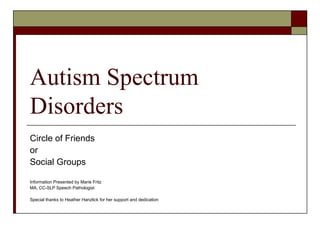
Autism circle of friends
- 1. Autism Spectrum Disorders Circle of Friends or Social Groups Information Presented by Marie Fritz MA, CC-SLP Speech Pathologist Special thanks to Heather Hanzlick for her support and dedication
- 2. WHY? Communication Challenges Imitation Joint Attention Social Challenges Social Focus Shifting Focus Challenge with unstructured time Anxiety Predetermined expectation Resultant Behavioral challenges
- 3. When Should I Start? The sooner you start a group the more growth a child develops. Start some form of the group in Kindergarten or before. More ‘formalized groupings’ are done for students having more characteristics of ASD but each child should have the opportunity to be part of a group in which they can develop ‘their’ social skills.
- 4. How Do I Start a Group? Get parental permission to start the group and add it to the child’s IEP. This is done at the team meeting. A letter is sent home to all parents in the child’s class telling them about the child with ASD and the purpose of the group. Parents are informed that there will be a voluntary sign up sheet at school where their child can volunteer to be a peer helper with the group. You may have sign up for a class or for the whole grade level. Children sign up on a voluntary basis. The children who sign up may decide to terminate their involvement at any time. See Peer Program Checklist for additional information and section with handouts.
- 5. How Do I Know What to Target? Initial assessment needs to be Kathleen Ann Quill – Do completed in the social and Watch Listen Say communication areas. Ron Leif – A Work in Progress Some very good resources are: Pragmatic Checklists Communication Samples to determine how a child is using language (i.e. Language functioning)
- 6. Important….. It is important to have a good understanding of ‘Normal’ pragmatic development and communication development. You then compare the ‘normal’ development to the child you are working with and determine goals. You can contact your speech therapist for information as well as numerous resources on the web about communication and pragmatic development. Some of the resources listed will assist you in this area.
- 7. Planning Group Goals….. Go through the social skills observation forms and communication evaluation with the team. Always get parent input on goals for the group. Pick the most relevant targets to assist the child from a functional standpoint.
- 8. Data Collection….. Use some form of goal pages to check off what goals were targeted on which days. Initially, you may be completing goals that require much prompting (physical, visual, verbal). Later you may be looking for generalization of previously taught skills (1-1 setting) in the circle of friends group. Make the data collection EASY! Remember the data will drive the skills taught.
- 9. Before Starting….. It is very beneficial to talk to the class about the student with ASD (i.e. disability awareness). This is done best when the student with ASD is in another location. Remember to get parental permission prior to speaking to the class. It works well to have the parent talk to the class about their child. You may wish to talk to the class with the parent. Talk to you counselor about scenarios regarding individual differences (i.e. the gift). There are also serveral books on ASD that can be read to a classroom.
- 10. Group Dynamics: You may choose to have one student come with the student with ASD at first, then add more students (up to 5-6). The group dynamics will depend on your student and the team goals for that student. You may choose to group 1 or more students with ASD together with one or more ‘friends’. Start small then build the group as the children become familiar with the routine and expectations of the group.
- 11. When Does the Group Meet? Typically a circle of friends group meets at lunch and at recess: those unstructured times that can significantly challenge the coping skills of a child with ASD. A group can meet every day or on certain days of the week. This depends on the needs of the child. It is important that if the group does not formally meet each day that supports are in place for the unstructured time of lunch and recess – a peer buddy, overseeing play with a paraprofessional or another teacher. This scenario is typically furnished when a child is making good gains in the structured group and you wish to generalize the skills outside of the small group into playground play.
- 12. Who Facilitates the Groups? Anyone can facilitate the group as long as they have training in pragmatics and communication skills. Speech Pathologists, Occupational Therapists or Physical Therapists, Psychologist, ASD Consultants. Paraprofessionals Teachers Parents
- 13. How to facilitate communication…. The text “Teach Me Language” has some good communication starters and visual supports for prompting communication in the group. Use the child’s PECS system if they have one. If they need one develop one! Use the internet. There are many good sites with visuals available for social language. Books are a good resource: see attached list of resources. Kathleen Ann Quill’s book is particularly useful as well as Carol Gray’s work and Tony Atwood’s work on Friendship skill. Use visual supports for children with ASD. Use social stories, scripts, and power cards.
- 14. Handouts: Letters for volunteers Peer Program Checklist Pragmatic Communication Skills Social skills/behaviors Lunch Bunch and checklist Examples of social programs: Dr. Kamps, Terrance’s Snack, Obstacle Course Training Components Information on training pragmatic or “social” skills Resources